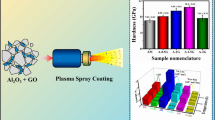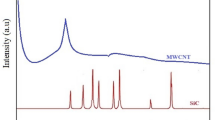Abstract
Aluminum-based composites containing 0.1-0.7 wt.% graphene were produced by the powder metallurgical process. The microstructure of the nanocomposites was studied using LM, SEM, EDS, TEM, and XRD. A relatively uniform distribution of graphene nano-platelets and compacted agglomerates in composites with different graphene contents was found. A mechanical bond between the nano-platelets and the aluminum matrix was established. Under the conditions used, neither particles nor nanoparticles of Al4C3 are formed. The microhardness and mechanical properties were studied. It was found out they are the highest in the composite containing 0.1% graphene. The change of these properties with the graphene content increasing has the same character. Agglomeration of GNPs occurs in all composites containing graphene, but a part of GNPs remain in a dispersed, non-agglomerated state. The microhardness and mechanical properties depend on this part of individual GNPs. It was proven that the observed increase in the yield strength of the studied composites is due to Orowan's strengthening mechanism. The fracture mechanism of GNPs de-bonding and pull-out from the aluminum matrix of the composite was experimentally proved.








Similar content being viewed by others
References
Ö. Güler and N. Bagcı, A Short Review on Mechanical Properties of Graphene Reinforced Metal Matrix Composites, J. Mater. Res. Technol., 2020, 9(3), p 6808–6833.
M.A. Rafiee, J. Rafiee, Z. Wang, H. Song, Z.-Z. Yu and N. Koratkar, Enhanced Mechanical Properties of Nanocomposites at Low Graphene Content, ACS Nano, 2009, 3(12), p 3884–3890.
F. Miao and C.N. Lau, Superior Thermal Conductivity of Singlelayer Graphene, Nano Lett., 2008, 8(3), p 902–907.
C. Lee, X. Wei, J.W. Kysar and J. Hone, Measurement of the Elastic Properties and Intrinsic Strength of Monolayer Graphene, Science, 2008, 321(5887), p 385–388.
C. Lee, X. Wei, Q. Li, R. Carpick, J.W. Kysar and J. Hone, Elastic and Frictional Properties of Graphene, Phys. Status Solidi (B), 2009, 246(11–12), p 2562–2567.
M.C. Şenel et al., Effect of Graphene Content on Tensile Strength and Microstructure of Aluminum Matrix Composites, Univ. J. Mater. Sci., 2018, 6(3), p 79–84. https://doi.org/10.13189/ujms.2018.060301
M.C. Şenel et al., An Investigation into the Mechanical Properties and Microstructures of Graphene Reinforced Aluminum Composites, Int. J. Res. Chem. Metall. Civ. Eng. (IJRCMCE), 2018, 5(1), p 5–8.
J. Li et al., Microstructure and Tensile Properties of Bulk Nanostructured Aluminumgraphene Composites Prepared via Cryomilling, Mater. Sci. Eng. A, 2015, 626, p 400–405.
T. Varol and A. Canakci, Microstructure, Electrical Conductivity and Hardness of Multilayer Graphene/Copper Nanocomposites Synthesized by Flake Powder Metallurgy, Met. Mater. Int., 2015, 21, p 704–712.
X. Gao et al., Preparation and Tensile Properties of Homogeneously Dispersed Graphene Reinforced Aluminum Matrix Composites, Mater. Des., 2016, 94, p 54–60.
L. Zhang et al., Aluminum/Graphene Composites with Enhanced Heat-Dissipation Properties by in-Situ Reduction of Graphene Oxide on Aluminum, Particles, J. Alloys Compd., 2018, 748, p 854–860.
S. Yan, C. Yang, Q. Hong, J. Chen, D. Liu and S. Dai, Research of Graphene-Reinforced Aluminum Matrix Nanocomposites, J. Mater. Eng., 2014, 4, p 1–6.
J. Wang et al., Effect of the Graphene Content on the Microstructures and Properties of Graphene/Aluminum Composites, New Carbon Mater., 2019, 34(3), p 275–285.
Du. Xiaoming, K. Zheng and F. Liu, Microstructure and Mechanical Properties of Graphene-Reinforced Aluminum-Matrix Composites, Mater. Technol., 2018, 52(6), p 763–768.
X.M. Du et al., Investigation of Graphene Nanosheets Reinforced Aluminum Matrix Composites, Dig. J. Nanomater. Biostruct., 2017, 12(1), p 37–45.
X.M. Du, R.Q. Chen and F.G. Liu, Investigation of Graphene Nanosheets Reinforced Aluminum Matrix Composites, Dig. J. Nanomater. Biostruct., 2017, 12(1), p 37–45.
J.L. Li et al., Microstructure and Tensile Properties of Bulk Nanostructured Aluminum/Graphene Composites Prepared via Cryomilling, Mater. Sci. Eng. A, 2015, 626, p 400–405.
A. Saboori, M. Dadkhah, P. Fino and M. Pavese, An Overview of Metal Matrix Nanocomposites Reinforced with Graphene Nanoplatelets Mechanical, Electrical and Thermophysical Properties, Metals, 2018, 8, p 423. https://doi.org/10.3390/met8060423
S.F. Bartolucci et al., Graphene–aluminum nanocomposites, Mater. Sci. Eng. A, 2011, 528, p 7933–7937.
G. Li and B. Xiong, Effects of Graphene Content on Microstructures and Tensile Property of Graphene-Nanosheets/Aluminum Composites, J. Alloys Compd., 2017, 697, p 31.
B. Xiong et al., Strengthening Effect Induced by Interfacial Reaction in Graphene Nano-Platelets Reinforced Aluminum Matrix Composites, J. Alloy. Compd., 2020, 845, 156282.
Z. Y et al., Effect of Ball Milling Time on Graphene Nanosheets Reinforced Al6063 Composite Fabricated by Pressure Infiltration Method, Carbon, 2019, 141, p 25–39.
W. Zhou et al., Interfacial Reaction Induced Efficient Load Transfer in Few-Layer Graphene Reinforced Al Matrix Composites for High-Performance Conductor, Compos. B, 2019, 167, p 93–99.
A. Saboori, M. Pavese, C. Badini and P. Fino, Microstructure and Thermal Conductivity of Al–Graphene Composites Fabricated by Powder Metallurgy and Hot Rolling Techniques, Acta Metall. Sin. (Engl. Lett.), 2017, 30(7), p 675–687. https://doi.org/10.1007/s40195-017-0579-2
J. Li, X. Zhang and L. Geng, Effect of Heat Treatment on Interfacial Bonding and Strengthening Efficiency of Graphene in GNP/Al Composites, Compos. A, 2019, 121, p 487–498.
W. Chen, T. Yang, L. Dong et al., Advances in Graphene Reinforced Metal Matrix Nanocomposites: Mechanisms, Processing, Modelling, Properties and Applications, Nanotechnology and Precision, Engineering, 2020, 3, p 189–210. https://doi.org/10.1016/j.npe.2020.12.003
J.L. Li, Y.C. Xiong, X.D. Wang, S.J. Yan, C. Yang, W.W. He et al., Microstructure and Tensile Properties of Bulk Nanostructured Aluminum/Graphene Composites Prepared via Cryomilling, Mater. Sci. Eng. A-Struct., 2015, 626, p 400–405.
J. Zhang et al., Microstructure and Mechanical Properties of Aluminium-Graphene Composite Powders Produced by Mechanical Milling, Mech. Adv. Mater. Mod. Process., 2018, 4, p 4. https://doi.org/10.1186/s40759-018-0037-5
J. Zhang, Z. Chen, J. Zhao and Z. Jiang, Microstructure and Mechanical Properties of Aluminium-Graphene Composite Powders Produced by Mechanical Milling, Mech. Adv. Mater. Mod. Process., 2018, 4, p 4. https://doi.org/10.1186/s40759-018-0037-5
M. Rashad, F. Pan, A. Tang and M. Asif, Effect of Graphene Nano-Platelets Addition on Mechanical Properties of Pure Aluminum Using a Semi-Powder Method, Prog. Nat. Sci. Mater. Int., 2014, 24, p 101–108.
M. Hasanzadeh Azar et al., Investigating the Microstructure and Mechanical Properties of Aluminum-Matrix Reinforced-Graphene Nanosheet Composites Fabricated by Mechanical Milling and Equal-Channel Angular Pressing, Nanomaterials, 2019, 9(8), p 1070.
M. Khan et al., Study of Microstructure and Mechanical Behaviour of Aluminium Alloy Hybrid Composite with Boron Carbide and Graphene Nano-Platelets, Mater. Chem. Phys., 2021, 271, 124936.
M. Li et al., Microstructure Evolution and Properties of Graphene Nano-Platelets Reinforced Aluminum Matrix Composites, Mater. Charact., 2018, 140, p 172–178.
Le. Zhang et al., Aluminum/Graphene Composites with Enhanced Heat-Dissipation Properties by In-Situ Reduction of Graphene Oxide on Aluminum Particles, J. Alloys Compd., 2018, 748, p 854e860.
S.K. Pradhan et al., Graphene-Incorporated Aluminum With Enhanced Thermal and Mechanical Properties for Solar Heat Collectors, AIP Adv., 2020, 10, p 065016. https://doi.org/10.1063/5.0008786
T. Knych et al., New Graphene Composites for Power Engineering, Materials, 2022, 15, p 715. https://doi.org/10.3390/ma15030715
L. Anestiev, R. Lazarova, P. Petrov, V. Dyakova and L. Stanev, On the Strengthening and the Strength Reducing Mechanisms at Aluminium Matrix Composites Reinforced with TiCN Nano-Sized Particulates, Philos. Mag, 2020, 101(2), p 129–153. https://doi.org/10.1080/14786435.2020.1821114
J. Humphreyes and P.B. Hirsch, The Deformation of Single Crystals of Copper and Copper–Zinc Alloys Containing Alumina Particles II Microstructure and Dislocation–Particle Interactions, Proc. R. Soc. (Lond.) A, 1970, 318, p 73–92.
P.M. Hazzledine and P.B. Hirsch, A Coplanar Orowan Loops Model for Dispersion Hardening, Philos. Mag., 1974, 30, p 1331–1351.
P. Haasen, Mechanical Properties of Solid Solutions. Chapter 23, Physical Metallurgy, Vol 3, 4th ed., R.W. Cahn, P. Haasen Ed., North-Holland, Amsterdam, 1996
Author information
Authors and Affiliations
Corresponding author
Additional information
Publisher's Note
Springer Nature remains neutral with regard to jurisdictional claims in published maps and institutional affiliations.
Appendix
Appendix
From the theory is known that the moving dislocations interact with the differently sized reinforcement particles differently. Recall that the strengthening effect of the reinforcement particles manifests itself in two different ways: (1) when below \(\left\langle {r_{p} } \right\rangle_{{{\text{crit}}}}\) it is due to the friction that the dislocation experiences when cutting through the reinforcement particle, (2) above this size it is due to looping of the dislocation around the reinforcement, i.e., the Orowan’s mechanism. In the theory of dislocations is shown that the critical size of the reinforcing particle, which distinguishes these two mechanisms, is related to the mechanical properties of the matrix and the reinforcement as follows:
Here, E is the Young modulus of the reinforcer and Γ is the antiphase boundary energy (Jm−2), which varies depending on the degree of the coherence between the lattices of the reinforcer and the matrix (according to Ref 37) for coherent lattices Γ = 0.1 Jm−2, while for the non-coherent lattices it is Γ = 1 Jm−2). Replacing in, EAl = 398 GPa, νAl = 0.23 and assuming a semi-coherence between the lattices of the reinforcer and the Al-matrix, Γ =0.5 Jm−2, for the critical radius is obtained, \(\left\langle {r_{p} } \right\rangle_{{{\text{crit}}}}\)~14 nm, or ~2 nm for non-coherent lattices. The mismatch between the experimental and the evaluated relative yield strength, therefore, suggests that a certain coherency exists between the lattices of the GNP and the Al.
Rights and permissions
About this article
Cite this article
Lazarova, R., Mourjeva, Y., Petkov, V. et al. Microstructure and Mechanical Properties of Aluminum: Graphene Composites Produced by Powder Metallurgical Method. J. of Materi Eng and Perform 31, 10162–10170 (2022). https://doi.org/10.1007/s11665-022-07012-y
Received:
Revised:
Accepted:
Published:
Issue Date:
DOI: https://doi.org/10.1007/s11665-022-07012-y




